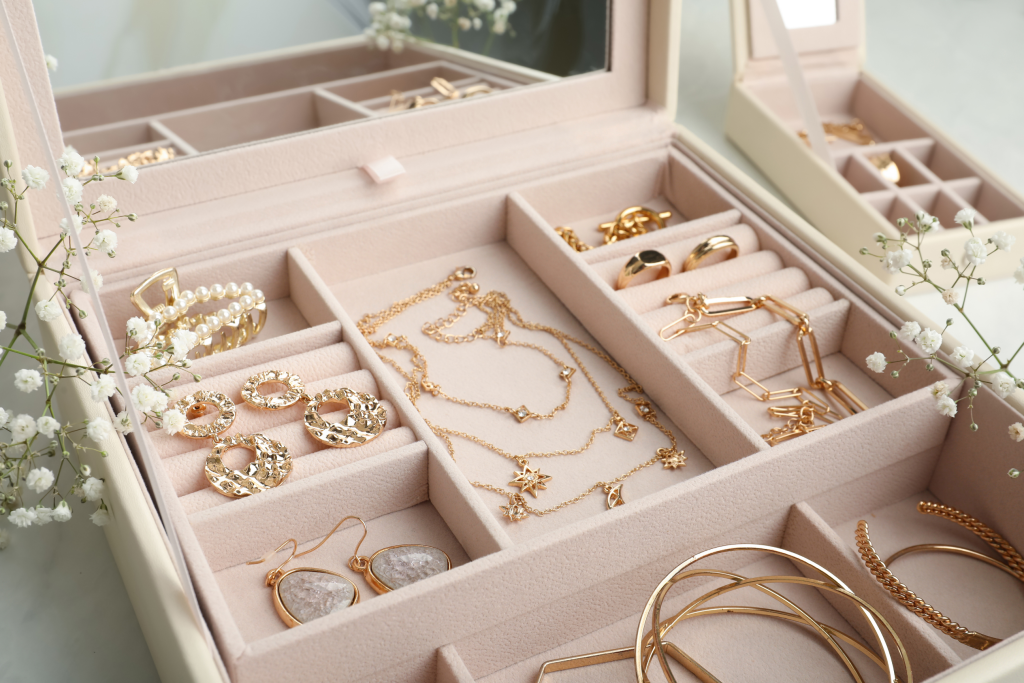You know what they say, diamonds are a girl’s best friend. But let’s remember all the other gorgeous pieces of jewelry out there, like sparkly earrings, chunky bracelets, classic watches, and delicate necklaces. They’re important, too!
So what can we do if something terrible happens to our beloved bling? That’s where jewelry insurance comes in! Jewelry insurance can protect you from loss, theft, damage, or mysterious disappearance of your personal jewelry.
Like other insurances, you provide some details about each piece you want to insure. If something happens, you make a claim to cover part or all of the cost to repair an item or to replace it with a similar item of equal quality and value.
Take note, though. There may be restrictions or conditions for certain types of jewelry, and there might be a deductible or coverage limit, so make sure you read the fine print before you sign up.
Let’s explore the ins & outs of jewelry insurance.
How Do I Get Jewelry Insured?
Adding jewelry coverage to an existing homeowners insurance policy is a common move. This add-on is known as a “floater policy” and covers all types of valuables, like jewelry, artwork, antiques, and more. It’s called a “floater” because the coverage stays with the item, regardless of where it’s located or how it is used.
To get this coverage, you’ll need to give the insurance company all the details about your jewelry, like what it’s made of, how much it weighs, and how much it’s worth. You’ll also need to provide some proof, like a receipt or appraisal, to show the value and location of each piece.
Does Home Insurance Cover Jewelry That’s Kept At Home?
You might think your home insurance covers your jewelry if it’s in your house, but in reality, standard home insurance usually only provides limited coverage for personal belongings like jewelry. So, if you have some pricey pieces, a basic policy might only partially replace them if they’re lost or damaged.
To improve the protection of your jewelry, you might consider adding extra insurance as the “floater” policy mentioned above, but you’re not limited to that option. If you don’t have home insurance, you can get your jewelry insured with a standalone policy that explicitly provides dedicated coverage for your valuables. This way, you can protect your bling and not mix it in with coverage for the rest of your stuff.
What Exactly Does Jewelry Insurance Cover?
When it comes to jewelry insurance, the extent of coverage you receive can vary based on the policy you choose. The most common coverage options — protection against loss, theft, and damage — can be had with most insurance companies. However, some will offer additional coverage options that go beyond basic coverage and include coverage for mysterious disappearance, loss of stones, and faulty repair.
Jewelry insurance typically covers:
- Theft: Besides theft from your home or a safe deposit box, this can also include coverage if the jewelry is stolen while wearing or carrying it.
- Loss: This includes misplacement of the jewelry or even losing it in a situation like a ring slipping off your finger and falling into a sewer drain or a necklace coming undone while you’re kayaking and falling into a lake. Just because you can’t recover it doesn’t mean it can’t be covered.
- Mysterious disappearance: This covers situations where the jewelry goes missing, and there’s no sign of theft.
- Loss of stones: This covers individual stones or gems that may come off of a piece of jewelry and end up lost.
- Damage: Accidentally breaking or scratching your jewelry is also coverable.
- Faulty repair: You can also buy coverage to protect you if your jewelry gets damaged while being fixed or transported.
Jewelry insurance typically will not cover:
- Intentional damage: If you deliberately and purposefully harm your jewelry, insurance won’t have your back.
- Normal wear and tear: Insurance usually won’t pay up for jewelry that’s merely showing its age from everyday use.
- Loss or damage while not in your care: If jewelry is lost or damaged when it’s not in your possession, like leaving it in a hotel room, insurance may not cover it.
- Loss or damage from war: Jewelry won’t be covered if lost or damaged during events like civil unrest, a war, or a nuclear event.
- Loss or damage from natural disasters: Jewelry insurance also won’t cover pieces that are lost or damaged due to events like floods, hurricanes, earthquakes, or fires.

How Much Will Jewelry Insurance Cost?
It can be challenging to estimate the cost of jewelry insurance without the specifics of your individual piece. First, you’ll want to get your insured items appraised — in fact, your insurer will require it. To determine the current value of your jewelry, an independent appraiser will record the weight, material, markings, quality, and rarity of a gem. They may also look at the manufacturing of the piece.
When coming up with a policy cost, your insurance provider might also consider whether or not the piece has any historical significance, how frequently it’s used, and where it’s kept when not in use.
Different insurers have different options and prices, but here are a few factors that impact the cost of jewelry insurance across the board:
- Value of the jewelry: If your piece is worth more, insurance premiums are likely to be higher since it’s a more considerable risk for the insurance company.
- Coverage amount: The more coverage you need, the higher the premium, and vice versa.
- Deductible: This is the amount you pay out of pocket before insurance kicks in. If you choose a higher deductible, you’ll have a lower premium. Conversely, a lower deductible means a higher premium.
Does Jewelry Have To Be Expensive To Be Insured?
Good question! For privacy reasons, the level of insurance taken out on most anything is pretty safely guarded, so the most expensive piece of jewelry ever insured is a mystery to us all.
It could be the Hope Diamond valued at $350 million or the Queen Mother at $520 million. While the details of their insurance aren’t made public, it’s standard for jewelry worth a lot of money to be insured and kept safe.
The same goes for your grandmother’s engagement ring! Besides monetary value, we want to protect things that hold sentimental and emotional importance. And jewelry often does that!
Here are some of the most popular types of jewelry insured:
- Diamond necklaces
- Engagement rings
- Gold or silver bracelets
- Heirloom brooches
- High school and college alumni rings
- Jewelry featuring precious gemstones
- Pearl earrings
- Wedding bands
- Wristwatches
Oh, one more! You have to assume that professional football players insure their championship rings, given their status and value. Super Bowl rings can be appraised between $30,000 to $50,000 depending on factors such as gems, features, and the specific game the ring is tied to. Former New York Giants linebacker Lawrence Taylor auctioned his Super Bowl XXV ring for over $230,000. We’ll bet its new owner insured it the following day!
What About Antique And Vintage Jewelry?
Some jewelry —like antique or vintage pieces — may have higher values and more unique features than more common jewelry. Because of this, special conditions and coverage restrictions may apply to any insurance taken out on them.
Some policies may come with a maximum coverage limit on antique or vintage jewelry items, meaning that there is a cap on the amount of money the policy will pay out in the event of a loss. They might also require the policyholder to “schedule” antique or vintage jewelry items separately on the policy rather than including them under the general personal property coverage.
How Do I Make A Claim?
Policyholders usually need proof of their loss when filing a claim. After filing, the insurance company will assess their coverage. If they determine the claim to be valid, they will either cover the cost of repairing the jewelry or provide reimbursement for its replacement.
But it all starts with you gathering the necessary documentation. Some, like the appraisal and receipts, would have been necessary when you took out the policy. Here are a few steps to help make the process smoother when making a claim:
- Get a hold of the police report: In the case of theft, it’s important to file a police report as soon as possible. This will provide an official record, which can be used as proof of loss.
- Keep appraisals up-to-date: If your jewelry has the potential to increase in value, you may want to get it appraised annually. This will provide an accurate assessment of the value of your insured jewelry.
- Keep all receipts: It’s important to have receipts from the purchase of the insured jewelry as proof of original value and ownership.
- Take photos: Having clear, detailed pictures of your insured jewelry can also help document their value and condition and be used as supporting evidence.
How Does Jewelry Insurance Payout?
Jewelry insurance typically pays out either by replacing the lost or damaged item with a new one, reimbursing the policyholder for the item’s value at the time of loss, or reimbursing for the cost of a repair to return the piece to its original condition.
Replacement:
When a jewelry insurance policy covers replacing a lost or damaged item, the insurance company will typically work with you to pay for a new item of the same make and model or a similar item of comparable value and quality.
In most cases, the insurance company may require proof of value before proceeding with the replacement or reimbursement. Once they’ve determined the value and the cost of a suitable replacement, they may arrange for the purchase and delivery of the replacement item directly to you. Other companies may cut you a check for you to cash or use to replace the item yourself.
Repair:
When a jewelry insurance policy covers reimbursement for jewelry repair, they may ask you to take the damaged item to a qualified jeweler or repair specialist for an estimate. In some cases, the insurance company may choose to have the item repaired by a specific jeweler or repair specialist.
Once they review the repair estimate and determine it’s reasonable, they will typically issue payment to the policyholder for the cost of repairs or pay the repairer directly.
Protect What’s Precious
Before getting jewelry insurance, it’s super important to carefully review the policy’s terms and conditions. This will give you a clear understanding of what is and isn’t covered and help you to make an informed decision about the best policy for your needs.
That’s where we come in. The team at Guided Solutions has got you covered. We’ll compare policies from different companies, ask questions, and comb through the fine print to help you find the right policy that fits your bling and your budget.










